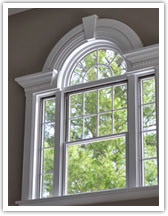Getting to Know the Different Types of Crown Molding Materials
 A form of cornice molding, crown molding is designed to gracefully proved a traditional look to hallways, living areas, dining rooms and bedrooms. Crown molding will aesthetically join the wall and ceiling, concealing the plain right-handed intersection, providing a pleasant appearance. In addition to capping walls and pilasters, crown molding may be used for cabinets, and is used extensively in the creation of interior and exterior cornice assemblies and door and window hoods. Crown molding is produced in a variety of materials, some which may be shaped with crown molding router bits, while others are manufactured with decorative patterns. Today we will talk about the different types of materials that are available to you for crown molding project.
A form of cornice molding, crown molding is designed to gracefully proved a traditional look to hallways, living areas, dining rooms and bedrooms. Crown molding will aesthetically join the wall and ceiling, concealing the plain right-handed intersection, providing a pleasant appearance. In addition to capping walls and pilasters, crown molding may be used for cabinets, and is used extensively in the creation of interior and exterior cornice assemblies and door and window hoods. Crown molding is produced in a variety of materials, some which may be shaped with crown molding router bits, while others are manufactured with decorative patterns. Today we will talk about the different types of materials that are available to you for crown molding project.
Crown molding is available in wood or other manufactured finishes such as plaster, MDF, polyurethane, flexible, aluminum and polystyrene. As each type of crown molding presents it’s own set of advantages, you must research the type of molding that will work best for your project.
Hardwoods
For a complete, finished look, natural wood is a traditional material whose hardwoods like oak and mahogany stain beautifully. Stained solid wood crown molding will add color and warmth to any room, and because the material is routable, hardwoods allow us to create any pattern we like when using crown molding router bits.
Softwoods
Softwood crown moldings, such as pine or aspen, is often a cheaper alternative than high-grade solid wood moldings due to the greater availability of trees. They are easier to cut and sand than hardwoods, and make an excellent choice for moldings that will be painted. These too are routable, allowing us to create any pattern we like when using crown molding router bits.
MDF
Crown molding made from MDF (a wood-based composite material that uses wood fibers with a synthetic resin) is another inexpensive alternative for homeowners and contractors to add beauty to a home. MDF won’t split when cutting, is easy to cut with miter saw blades, is resistant to warping and can be painted with any high quality oil or latex paint, making it one of the most versatile types of crown molding on the market today.
Polyurethane
This crown molding is resistant to weather, scratching and erosion, making it one of the most durable types of crown molding. However it is generally manufactured in white and will not hold paint or stain for a proper finishing.
Flexible
When you find yourself presented with a doorway or curved window, the above choices will not help you complete your molding project. For this we have flexible crown molding, which won’t break or split, thus making it easy to decorate around curved windows and doorways. Flexible molding is one type of polyurethane, which is formed from a polymer resin, that is engineered to curve and bend around shapes other than a standard 90º angle.
Aluminum, Copper & Steel
Often used for exteriors, stamped metal crown molding features heavy-duty construction available for use as a decorative accent. It is preformed inside and outside corners eliminate miter cuts, making installation easy. It is easy to cut with steel cutting saw blades, and installs like traditional moldings. It may also be used for retail spaces, workshop, garages, kitchens, offices and trade shows.
Conclusion
Whether you decide to use crown molding along the tops of your wall or window, as a decorative element on your furniture, or as part of your exterior, the beauty of your particular project will be intelligently enhanced when choosing this type of molding.


